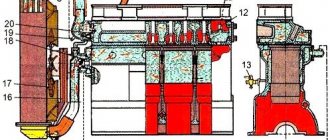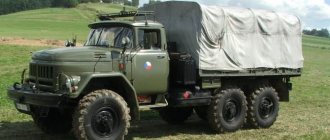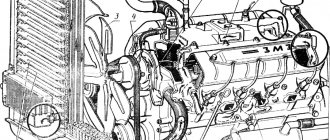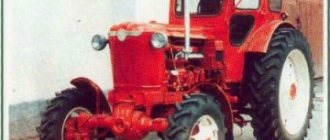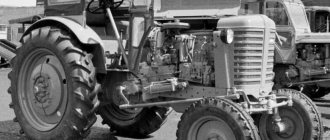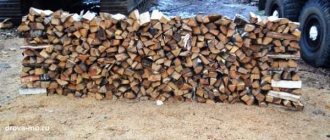How often do we, when buying our future car, ask the seller for various characteristics. We are interested in cost, maximum speed, engine size, and various technical innovations. And this applies not only to cars.
Today we will study the issue of the volume of the UAZ “Loaf” tank.
During the time from its first appearance in public to the most recent modifications, this car also changed its performance. This includes both speed and appearance. The same is appropriate to say about the fuel tank itself.
If we recall the process of fuel supply, we will say that it flows through a special tube.
The car has two fuel tanks. The main tank is on the left and holds 56 liters, and the second tank - 30 liters, although this volume has changed, it is important to take into account the modification of the car.
Thus, the current constant volume of the “Loaf” fuel tank is 56 liters.
UAZ vehicles are often operated in the harshest conditions and high autonomy is important for them - this problem is solved by the presence of two large-volume fuel tanks. Read about UAZ fuel tanks, their purpose, functionality and operating features, as well as about maintenance and repair in this article.
What are the components?
Refill tanks are units that contain working fluids. They periodically require replacement or refueling, just like with a gas tank. By the way, the UAZ Patriot SUV is equipped with two refueling tanks, which allows you to increase the amount of fuel to be filled to almost 80 liters. Few cars of this class can afford such a gas tank design.
Refill volumes include the following devices, mechanisms and parts:
- gas tanks;
- Patriot engine cooling system;
- Transmission;
- the engine, or rather its lubrication system;
- housings of both axles;
- hydraulic power steering system;
- brake system;
- clutch system;
- glass washer pump reservoir;
- transfer case.
UAZ Patriot, as well as other vehicles similar in design and having similar mechanisms, necessarily has the refueling volumes listed above, presented in the form of plastic tanks or located directly in the units themselves. It is in these devices that the filling fluid for a particular mechanism is located. These liquids include the following:
- gasoline or diesel fuel, depending on the design of the engine itself;
- motor and transmission oils, which are filled not only into the engine, but also into the gearbox, transfer case and axles;
- brake fluid poured into the brake mechanism and clutch system of an SUV;
- antifreeze or antifreeze, used for engine cooling and interior heating;
- windshield washer fluid, which is filled into the windshield and rear window washer reservoir.
So, now let's look at the digital values of all the above-mentioned devices, what volumes of working fluid they have and what they represent.
Refueling volumes
For Patriot, refueling volumes correspond to the following data:
- gas tanks: the left tank is designed for 36 liters, as stated by the manufacturer, the right one has the same volume and is 36 liters, although in fact it is known that you can add a little more fuel to the gas tanks;
- the volume of the engine lubrication system is 7 liters, and for UAZ Patriot 31631 models the amount of lubricant is 4.2 liters;
- engine cooling and interior heating system - 12 l, and for a radiator with horizontal tubes the capacity is 14 l;
- The manual gearbox has a volume of 2.5 liters;
- the transfer case is about 0.8 liters;
- The front and rear axles of the rogue have filling volumes that differ in value from each other. So, for the front axle the typical oil filling is 1.5 liters, and for the rear axle - 1.4 liters. But in fact, it is recommended to pour more than 1.4 liters of oil into the rear axle housing so that the working elements inside are completely absorbed by the lubricant;
- power steering - 1.1, and for the UAZ-31631 model - 1.3l;
- steering gear - 0.25;
- clutch drive is 0.18l;
- brake mechanism - 0.6l;
- shock absorbers - 0.32, but it all depends on the devices used in the suspension design;
- The windshield washer reservoir is 5 liters.
All these parameters are important and every owner of his car should have all the numbers. Otherwise, you can always refer to the car’s operating instructions and find out even the smallest details. If you have questions or feedback, you can always leave it at the end of each material.
Lubricants
- motor oil
M-8-V, GOST 10541-78 or M-6z/10-V (DV-ASZp-10V) OST 38.01370-84. Northern automobile oil M4z/6V1 OST 38.01370-84. - transmission oil
TSp-15K GOST 23652-79. Substitute: automotive transmission oil TAP-15V or TAD-17I OST 23652-79. At temperatures below minus 20 °C, automotive transmission oil TSp-10 GOST 23652-79. - Lubricant
"Litol-24" GOST 21150-87, "Lita" TU 38.1011308-90 or "Litol-24RK" (grease SHRUS-4 - an analogue of "Litol" with the addition of molybdenum disulfide and other additives that reduce wear) - Graphite lubricant
USSA GOST 3333-80. - Grease
CIATIM 201 GOST 6267-74, CIATIM-221 GOST 9433-80.
Working fluids
- Coolant
TOSOL-A40M, TOSOL-A65M TU 6-02-751-86 (use in winter OZH-40, OZH-65 GOST 28084-89 is allowed) or “Lena-40”, “Lena-65” TU 113- 12-11.104-88. The water is clean and “soft” (rain, snow, boiled). - Shock absorption fluid
AZh-12T GOST 23008-78. Substitute: spindle oil AU OST 38.01.412-86. - Brake fluid
“Tom” TU 6-01-1276-82, “Rosa” TU 6-55-37-90, “Neva” TU 6-01-1163-78, GTZh-22 TU 6-01787-75 (see . also opinions about different brake fluids) - Electrolyte
with density, g/cm3: 1.25 - for areas with temperatures up to -10 ° C; 1.27 - for areas with temperatures up to -30 ° C; 1.29 - for areas with temperatures up to -40 ° C (see also the article “Battery”) - Gasoline
A-76 GOST 2084-77, summer or winter grades.
Refueling data for wagon-type vehicles
| Name | Car models | |||
| UAZ-3741, UAZ-37411 | UAZ-3962, UAZ-39621 | UAZ-2206 | UAZ-3303, UAZ-33031 | |
| FILLING DATA (in liters) | ||||
| Fuel tanks: | 56 | 56 | ||
| Basic | ||||
| Additional | 30 | 56* | ||
| Engine cooling system (including heater) | 12,2-12,4 | 13,4-13,6 | 13,4-13,6 | 12,2-12,4 |
| (12,9-13,1)** | (14,1-14,3)** | (12,9-13,1)** | ||
| Engine lubrication system (including oil filter and oil cooler) | 5,8 | |||
| Gearbox housing | 1,0 | |||
| Transfer case housing | 0,7 | |||
| Front and rear axle housing (each) | 0,853 | |||
| Steering gear housing | 0,25 | |||
| Shock absorbers (each) | 0,320 | |||
| Hydraulic clutch system | 0,18 | |||
| Hydraulic brake drive system | 0,52 | |||
| Windshield washer reservoir | 2 | |||
* Only the main tank can be installed ** Including starting heater Engine 417 mod., 4-speed gearbox
Standards for consumption of fuels and lubricants in road transport Р3112194-0366-97
approved by the Ministry of Transport of the Russian Federation on February 18, 1997. Valid until 01/01/2002) (Only basic figures, only in relation to UAZ vehicles. Full document: local copy from the Avto-Garant website)
Fuel consumption rates
The standards include the fuel consumption required for the transport process... For general purpose vehicles, the basic norm is established in liters per 100 km of vehicle mileage...
Fuel consumption rates increase (including) under the following conditions:
- work in winter: in the southern regions of the country - up to 5%, in the northern regions of the country - up to 15%, in the Far North and areas equivalent to the Far North - up to 20%, in other regions of the country - up to 10% ( the maximum values of winter allowances for almost all regions of central Russia are 10%, valid for 5 months a year);
- work in cities with a population of over 2.5 million people - up to 20%; with a population of 0.5 to 2.5 million people - up to 15%; with a population of up to 0.5 million people - up to 10%;
- when driving the first thousand kilometers with cars that have been overhauled and new, as well as... when driving such cars under their own power - up to 10%;
- for cars that have been in operation for more than 8 years - up to 5%;
- work in difficult road conditions during seasonal thaw, snow or sand drifts, floods and other natural disasters - up to 35%;
Fuel consumption rates are decreasing (including):
- when working on roads outside the suburban area made of cement concrete, asphalt concrete, paving stones, mosaics on flat, slightly hilly terrain (altitude up to 300 m) - up to 15%.
In the case when the car is operated outside a city with a population of more than 2.5 million people. in a zone up to 50 km from the city border, as well as for cities with a population of 0.5 to 2.4 million people. in an area up to 15 km from the city border and with a population of less than 0.5 million people. in a zone of up to 5 km, correction factors (increasing or decreasing) are not applied. If it is necessary to apply several surcharges simultaneously, the fuel consumption rate is set taking into account the sum or difference of these surcharges.
For internal garage travel and technical needs... fuel consumption increases to 1.0% of the total; when cars are idle... in the winter and cold seasons with the engine running, set the standard fuel consumption at the rate of one hour of idle time corresponding to 5 km of vehicle mileage. For vans working on an hourly basis, the standard fuel consumption value is determined similarly to passenger cars, taking into account the surcharge for work with an hourly rate (10%).
Basic linear fuel consumption rate for vehicle mileage, l/100 km:
UAZ-469, -469A, -469B 16 UAZ-315100, -315101, -31512-01, -315201 16 UAZ-31512 15.5 UAZ-31514 16.65 UAZ-31517 (with HR 492 NTA engine) 11, 0 (diesel) UAZ-452A, -452AS, -452V 17 UAZ-220601 17 UAZ-220602 22 (gas) UAZ-3303-0001011 APV-04-01 17.5 UAZ-3962 17.5 UAZ-396201 17 UAZ- 450, -450D 16 UAZ-451, -451D, -451DM, -451M 14 UAZ-452, -452D, -452DM 16 UAZ-3303 16.5 UAZ-330301 16 UAZ-33032, -33032-01 21.5 UAZ -374101 16 UAZ-450A 17 UAZ-451A 17 UAZ-3741 “DISA-1912 Zaslon” 17.6 UAZ-374101 17 UAZ-3962 17.5 UAZ-396201 17
Lubricant consumption rates
Lubricant consumption rates are set per 100 liters of total fuel consumption, calculated according to the standards for a given vehicle. Oil consumption rates are set in liters per 100 liters of fuel consumption, lubricant consumption rates - respectively, in kilograms per 100 liters of fuel consumption... Oil and lubricant consumption rates are reduced by 50% for all vehicles in use for up to three years. Oil consumption rates increase to 20% for vehicles that have been in operation for more than eight years...
Consumption rates per 100 liters of total vehicle fuel consumption for models UAZ-469, -3151, -452, -2206, -3962, -450, -451, -452, -3303, -3741, -450A, -451A, -374101 , 396201 of all modifications is: Engine oil 2.2 l
Transmission oil
0.2 l
Special oil
0.05 l
Grease
0.2 kg
Utility vehicles produced by the Ulyanovsk Automobile Plant since 1989. Produced from 1972 to 1985. UAZ-469B and 469 cars with UMZ-451M engines with a power of 75 hp. With. were replaced by UAZ-31512-01 and UAZ-3151-01 vehicles, which were equipped with an UMZ-414 engine with a power of 80 hp. and separate brake drive. The UAZ-31512 and UAZ-3151 cars are produced with a UMZ-417 engine with a power of 90 hp. The UAZ-3151 differs from the UAZ-31512 in the presence of wheel gearboxes in the drive axles (increased ground clearance), shielded electrical equipment and an engine pre-heater. The body is four-door, with a removable awning and a tailgate. The front seats are attached to the floor in one of three positions. The backrests can be installed in one of two positions. Rear seats: one three-seat folding and two single seats (with reclining cushions).
Modifications:
UAZ-3152 (based on UAZ-31512), designed for transportation of medical personnel and patients, has sanitary equipment UAZ-31512-01 -UM-AP-GAI traffic police vehicle UAZ-31512-01-1M-ADCH task force vehicle
The main differences between these cars and the base one
The body is all-metal, five-door, divided into two compartments; number of seats - 6(7), including 5(2) in the front compartment, 4(2) in the rear compartment. The rear compartment is heated and ventilated by the main heating and ventilation system. The spare wheel is located in the rear compartment. The car is equipped with additional lighting, alarm and special equipment. Total weight - 2210 kg, overall height - 2500 mm.
Load capacity:
with 9-leaf springs 600 kg of cargo plus 2 people. or 100 kg plus 2 people with 7-leaf springs 400 kg cargo plus 2 people. or only 7 people.
Engine.
Mod.4178 (UAZ-31512) and 4179 (UAZ-3151), petrol, in-line, 4-cyl., 92×92 mm, 2.445 l, compression ratio 7.0, operating order 1-2-4-3, power 66 kW (90 hp) at 4000 rpm, torque 171.6 N*m (17.5 kgf*m) at 2200-2500 rpm; carburetor K-151V or K-126GU; air filter - inertial oil filter.
Transmission.
The clutch is single-disk, with peripheral springs, the release drive is hydraulic. Gearbox - 4-speed, with synchronizers in all forward gears; transmit. numbers for synchronized gearbox: I-3.78; II-2.60; III-1.55; IV-1.0; ZH-4.12; transmit. numbers for a gearbox with synchronizers in 3rd and 4th gears: I-4,124; II-2,641; III-1.58; IV-1.00; ZX-5.224. Transfer case - two-stage, gear. numbers: highest - 1.00; the lowest is 1.94. The cardan transmission consists of two shafts. The main gear is a bevel gear with spiral teeth; transmit. numbers: on UAZ-31512 - 4.625, on UAZ-3151 - 2.77 and wheel gearboxes - 1.94 (total gear ratio - 5.38).
Wheels and tires.
Wheels - with one-piece rim 6L-15. Tires - 8.40-15, air pressure in the front tires 1.7-1.9; rear - 1.9-2.1 kgf/cm. sq. , Number of wheels 4+1.
Suspension.
Front and rear - on two semi-elliptical 7- or 9-leaf springs with telescopic shock absorbers.
Brakes.
The service brake system has drum mechanisms (each pad of the front wheels is driven by a separate cylinder, both pads of the rear wheels are driven by one cylinder), a dual-circuit hydraulic drive (separate along the axes) and a vacuum booster. Option - hydraulic drive without amplifier. The parking brake is transmission, with a drum brake mechanism and a mechanical drive.
Steering.
The steering mechanism is a globoidal worm with a double-ridge roller, gear. number - 20.3.
Electrical equipment.
Voltage 12 V, ac. battery 6ST-60EM, generator G250-P2, voltage regulator PP132-A, starter 42.3708, breaker-distributor (on UAZ-3151) - P132, sensor-distributor (on UAZ-31512) - 3302.3706, ignition coils: on UAZ-31512 - B116, on UAZ-31251 - B102-B, transistor switch (on UAZ-31512) - 1302.3734, spark plugs: on UAZ-31512 - All, on UAZ-3151 - SN302-B. Fuel tank - 2x39 l, A-76 gasoline; cooling system (with heater) - 13l, water or antifreeze A-40, A-65; engine lubrication system - 5.8 l, M-8B, M-6/10V (DV-ASZp-10V); Gearbox housing - 1.0 l, TSp-15K (replacement for TAP-15V), at temperatures minus 20-45°C TSp-10 oil; transfer case housing - 0.7 l, steering gear housing - 0.25 l, drive axle housings - 2x1.0 l (UAZ-31512), - 2x0.85 l (on UAZ-3151); wheel gear housings - 2×0.3 l,
all around gearbox oil
; hydraulic brake system - 0.52 l; hydraulic clutch release system - 0.18 l; brake fluid "Tom"; shock absorbers - 4×0.32 l, shock absorber fluid AZh-12T or spindle oil AU; windshield washer reservoir - 2 l, water or NIISS-4 liquid mixed with water.
Weight of units
(in kg). Engine with clutch - 165; gearbox - 36, transfer case with parking brake - 37, driveshafts - 15, front axle - 120 (UAZ-31512) and 140 (UAZ-3151), rear axle - 100 (UAZ-31512) and 122 (UAZ-3151) ), frame - 112, complete body - 475, wheel and tire - 39, radiator - 10.
SPECIFICATIONS
| Model | 31512 | 3151 |
| Curb weight, kg | 1590 | 1680 |
| Including: | ||
| to the front axle | 870 | 900 |
| to the rear axle | 720 | 780 |
| Total weight, kg | 2150 | 2480 |
| Including: | ||
| to the front axle | 920 | 1020 |
| to the rear axle | 1230 | 1460 |
| Permissible trailer weight, kg | 850 | 1460 |
| Max vehicle speed, km/h | 115 | 110 |
| Max. climbability by car, hail | 31 | 31 |
| Control vehicle fuel consumption, l/100 km: | ||
| at 60 km/h | 10,5 | 11,6 |
| at 80 km/h | 13 | 14,5 |
| Braking distance from 80 km/h, m | 43,2 | 43,2 |
| Turning radius, m: | ||
| on the outer wheel | 6,3 | 6,5 |
| overall | 6,8 | 7 |
Thematic materials:
What is GOI paste and how to use it? Apple sorbet - a dessert with health benefits! Stewed meat with potatoes and prunes in pots Principles of proper nutrition by the hour and sample menu Sberbank credit card: loan repayment terms and payment options Sberbank credit card loan repayment terms example Help on the bank form: filling out Is it possible to get poisoned by chanterelles
103583
If you notice an error, select a piece of text and press Ctrl+Enter
Transmission
The transmission of the UAZ-220695-04 vehicle consists of the following elements: clutch, gearbox, transfer case, cardan transmission, drive axles.
Clutch - manufactured by ZMZ, diaphragm, dry friction, with torsional vibration damper. The clutch mechanism is bolted to the engine flywheel, balanced together with the crankshaft, and its position after balancing is marked on the housing and flywheel with an “O” sign.
The gearbox is a five-speed manual, currently sourced from Chinese manufacturer BAIC. The quality of work of this “mechanics” often causes complaints from owners and drivers of new “loaf” minibuses. Previously, minibuses of the UAZ-2206 family were equipped with a domestic mechanical four-speed ADS gearbox, equipped with inertial-type synchronizers.
The transfer case is two-stage, with the function of disabling the front axle drive. The transfer case distributes torque between the two drive axles of the machine. Also, an additional reduction gear in the transfer case provides, if necessary, an increase in traction on the drive wheels and doubles the gear range. Gear ratios – direct transmission: 1.00; reduction gear: 1.94.
How much oil is in the box of UAZ 469 ~ VESKO-TRANS.RU
Technical properties of the UAZ 469 car
The Russian SUV that is still popular today
The UAZ 469 all-terrain vehicle, which appeared in our country in the early 1970s, remained the best Russian jeep for a long time. Thanks to its high reliability, maintainability in field conditions and low price, this unpretentious hard worker still remains the standard all-wheel drive vehicle for many.
Really, what other car can you fill with a cloudy brownish liquid called A-72 gasoline, used motor oil and castor oil instead of brake water, and then drive our entire majestic country from end to end without ruining the engine and brake system. Changing the oil in the Renault Logan gearbox. The technical properties of the UAZ 469 are unique; they allow this jeep to be operated in conditions that would kill any other car.
The “goat” also has some drawbacks, namely, a tarpaulin awning instead of a regular roof and a weak stove, which make you click your teeth when traveling in the winter season. The answer to the question about how much oil is in the gearbox on a 16-valve VAZ-2112. How much oil to pour when changing? Changing the oil in the UAZ transfer case | car enthusiasts. But they are more than compensated by the understanding of the fact that along the way you won’t get stuck in a snowdrift and won’t freeze your limbs.
Basic characteristics of the body and engine
Brief description of the UAZ 469 (469B):
- body - metal, open;
- type - frame convertible station wagon;
- number of places - 7;
- number of doors - 5;
- length - 4025 mm;
- width - 1805 (1785) mm;
- height - 2050 (2015) mm;
- base - 2380 mm;
- ground clearance - 300 (220) mm;
- weight without load - 1600 (1540) kg;
- weight with full load - 2400 (2280) kg;
- volume of fuel tanks - 78 l.;
- highest speed - 90 (120) km/h;
- ford depth - 0.7 m;
- the greatest climbability with a driver and 1 passenger - 57°;
- the highest climbable height at full load is 31°.
Since the start of production, the UMZ 414 engine has been installed on the civilian modification of the SUV.
Military models were equipped with the same power unit, but with a pre-heater, so the motor has a different index - UMZ 41416.
- type - gasoline, atmospheric, 4-stroke;
- number of cylinders - 4;
- placement - in-line, vertical;
- operating order - 1-2-4-3;
- cylinder diameter - 92 mm;
- piston stroke - 92 mm;
- engine displacement - 2.5 l;
- compression ratio - 6.7;
- power - 75 l. With.;
- highest torque - 167 Nm;
- average gasoline consumption on the highway is 10.75 liters per 100 km;
- the highest gasoline consumption off-road - 17.25 liters per 100 km;
- weight of the UMZ 414 engine with attachments and clutch, but without fluids - 163 kg;
- weight of UMZ 41416 with canopies and clutch, but without fluids - 165 kg;
- volume of cooling water (WW) - 13 l;
- operating coolant temperature - 80-90°C;
- engine oil volume in the cylinder block - 5.8 l;
- normal oil pressure at idle speed is 0.5-0.8 kg/cm³;
- normal oil pressure at speed is 2-5 kg/cm³.
Changing the oil in the box of UAZ 469 79g.v
I decided to change the oil. UAZ 469, 31512, oil change in gearbox and transfer case of UAZ Patriot; Changing the oil in the gearbox and transfer case of the UAZ Patriot. How much oil is in the box of a VAZ-2112 16 valves volume in the gearbox. And this is what I saw. How much oil is in the gearbox of a VAZ/LADA 2110. Changing the oil in a UAZ gearbox | car enthusiasts. The new one was filled with TAD 17.
UAZ Changing the oil in the axle
Report video on Castrol 80w90 GL-5 oil Oil life in the UAZ Patriot gearbox Castrol 80w90 GL-5 Why is it tight.
Under the hood of the 469 model
Features of transmission, chassis and control systems
The unique characteristics of the UAZ 469 are largely due to the successful design of the transmission. This vehicle system consists of a dry single-plate clutch, a gearbox, a transfer case, a rear drive axle, a front axle, and wheel drives for an army modification of an SUV.
Technical characteristics of the gearbox:
- type - 4-speed, manual;
- synchronizers - in 3rd and 4th gears.
- 1st gear - 4.12;
- 2nd gear - 2.64;
- 3rd gear - 1.58;
- 4th gear - 1.00;
- reverse gear - 5.22;
- gearbox weight without lubrication - 33.5 kg;
- The volume of oil in the gearbox is 1 liter.
Transfer case specifications: 2-speed, manual.
- direct transmission - 1.00;
- low gear - 1.94;
- power take-off - up to 40%;
- weight with hand brake, without lubrication - 37.4 kg;
- the volume of oil poured is 0.7 l.
Cardan transmission - 2-shaft, open.
- front - 2-hinge, combined;
- front shaft weight - 6.9 kg;
- rear - 2-hinged, tubular;
- rear shaft weight - 8.25 kg.
- type - detachable, with gearboxes on all wheels;
- gear ratio - 5.38;
- final drive ratio - 2.77;
- gear ratio of wheel gearboxes - 1.94;
- front axle weight - 140 kg;
- rear axle weight - 121.5 kg;
- the volume of oil poured into each bridge is 1 l;
- the volume of oil poured into each wheel gearbox is 0.3 liters.
- type - detachable;
- final drive ratio - 5.13;
- front axle weight - 120 kg;
- rear axle weight - 100 kg;
- the volume of oil poured into each bridge is 0.85 l.
You can distinguish military bridges from collective farm ones in the photo by the conical cap on the splined flange and the double final drive.
- suspension - rigid, leaf spring;
- springs - 7-9 leaf, elliptical;
- shock absorbers - telescopic, double-acting;
- wheels - steel, stamped;
- tires - tube;
- The recommended tire size is 215/90 R15.
- mechanism - worm type;
- gear ratio - 20-21;
- the volume of oil to be filled is 0.25 l.
- type - hydraulic, drum;
- parking brake - transmission;
- liquid volume - 0.52 l.
In general, the control systems of the UAZ 469 are reliable and durable.
vesko-trans.ru
What fluids are needed for Patriot to work?
The domestic UAZ Patriot, which has a 409 engine, and a number of other cars that are similar in their mechanisms and design, are required to have the above-mentioned refueling tanks, which are presented in the form of tanks made of plastic and located in various units. It is in such devices that different working fluids are located. Check out the list of working fluids present in the UAZ Patriot:
- Transmission and engine oils are filled into the power unit, transfer case, as well as gearboxes and axles.
- Antifreeze or antifreeze is required for heating the interior and cooling the engine;
- Depending on the design of the power plant, diesel fuel or gasoline.
- Liquid intended for glass washers, poured into the rear and windshield washer reservoirs.
- Brake fluid is poured into the clutch system, plus into the brake mechanism.
Source of the article: https://ltruck-service.ru/brend/bak-uaz-buhanka.html
Different types of oils
Dexron
- a separate class of ATF fluids from General Motors, produced since 1968. Dexron is a trademark, produced both by GM itself and by other companies under license.
ATF
(Automatic Transmission Fluid) - oils for automatic transmissions, often used by Japanese automakers and in power steering.
P.S.F.
(Power Steering Fluid) - literally translated as power steering fluid.
Multi HF
– special, universal power steering fluids that have approvals from most automobile manufacturers. For example, CHF liquid, produced by the German company Pentosin, has received approvals from BMW, Ford, Chrysler, GM, Porsche, Saab and Volvo, Dodge, Chrysler.
Repair of steering control of UAZ-3962, UAZ-3741 cars
The steering of the UAZ-3962, UAZ-3741 car consists of a worm-roller type steering mechanism with a steering wheel (Fig. 14) and a steering gear (Fig. 16).
Fig. 14. Steering mechanism UAZ-3962, UAZ-3741
a-steering column with cardan joint; 1-bipod; 2-crankcase; 3-bottom cover; 4-adjusting shims for worm bearings; 5-roller; 6-worm; 7,8,29-bearings; 9-plug seal; 10-filler plug; 11-gasket; 12-side crankcase cover; 13-pin; 14-lock washer; 15.35 bushings; 16-shaft bipod; 17-cuff; 18-washer; 19-nut; 20-steering wheel; 21-column; 22- steering shaft; 23-bipod shaft bearing; 24- mesh clearance adjusting screw; 25-cap nut; 26-axis roller; 27-oil seal; 28-wire horn; 30.39-plastic bushings; 31-screw; 32-spacer sleeve; 33-protective washer; 34-hinge; 36-circlip; 37-spring; 38-pin bushing
Rice. 16. Steering gear UAZ-3962, UAZ-3741
1- longitudinal steering rod; 2- longitudinal steering rod lever; 3.6-levers steering linkage; 4.7 - tie rod ends; 5- tie rod
Rice. 15. Steering mechanism UAZ-3741, UAZ-3962 with power steering
1-nut; 2,5,6,19,21,22,35,39 - O-rings; 3-glass; 4.10-thrust bearings; 7-piston-rack; 8-screw; 9-crankcase; 11-injection hose fitting; 12-fitting drain hose; 13-sleeve; 14-cuff; 15-torsion bar; 16.38-pins; 17-ball drive; 18-balls; 20-channel in the crankcase; 23-bipod; 24-nut bipod; 25-protective bottom cover; 26-rings; 27-adjusting washers; 28-bipod shaft support; 29-rollers; 30-shaft bipod; 31-top protective cover; 32-rotor; 33-protective cap; 34-distributor housing; 36-channel in the distributor housing; 37-bolts securing the distributor housing to the crankcase
Removing the steering mechanism of UAZ-3741, UAZ-3962
Removing the steering mechanism of UAZ-3741, UAZ-3962 is carried out in the following order:
— Remove the turn signal switch.
— Disconnect the signal wire.
— Remove the signal button and contact parts.
— Unscrew the steering wheel fastening nut 2-3 turns and, using a puller, loosen the steering wheel fastening on the steering shaft cone.
— Unscrew the steering wheel nut and remove the steering wheel.
On vehicles with a steering column with a universal joint (see Fig. 14a), removal of the steering mechanism is possible without removing the steering column.
Dismantling the steering mechanism of UAZ-3962, UAZ-3741 worm-roller type
Disassemble the UAZ-3741, UAZ-3962 worm-roller steering mechanism in the following order:
— Unscrew the nut and remove the lock washer from the adjusting screw.
— Unscrew the bolts securing the side crankcase cover.
— Using a light blow of a copper or aluminum drift on the end of the bipod shaft, remove the bipod shaft along with the roller and cover and carefully remove the gasket. — By screwing the adjusting screw into the side cover of the crankcase, remove the side cover and the adjusting screw from the bipod shaft
— By screwing the adjusting screw into the side cover of the crankcase, remove the side cover and the adjusting screw from the bipod shaft.
— Unscrew the bolts securing the lower crankcase cover and remove the cover along with the gaskets, the outer ring of the lower bearing and the separator with rollers.
— Take out the crankcase shaft with the worm assembly and the separator with the rollers of the upper bearing.
— Press the outer ring of the upper bearing, the steering gear shaft cuff, the bipod shaft cuff and the bipod shaft bushing out of the steering gear housing only if they are replaced.
Assembling the steering mechanism of UAZ-3962, UAZ-3741, worm-roller type
Assemble the UAZ-3741, UAZ-3962 worm-roller steering mechanism in the reverse order of disassembly, taking into account the following:
— In case of replacing the worm when pressing it onto the shaft, it is necessary that the high spline of the worm coincides with the keyway of the shaft. The discrepancy between the end of the shaft and the end of the groove on the worm should not exceed 0.25 mm.
A little about the oil hose in the Patriot
This main element serves to connect the pump to the steering mechanism
It is not famous for its reliability, so the owner needs to pay special attention to it. If the driver notices a delayed reaction of the wheels to the rotation of the steering wheel, which can be especially pronounced at speed, then this should be a signal to check and subsequently replace the hose
“Thanks to” low-quality manufacturing materials, this hose tends to swell after a certain mileage, which means a loss of pressure in the system.
This state of the element can provoke a rush, which is a prerequisite for an emergency situation. Here the driver needs to have a spare hose with him. Purchasing it is not a problem, the main thing is to know the article number - “3163-00-3408150-01”. This version of the product has gained support from many owners. After replacement, the system will need to be bled. This will remove any remaining air in the circuit. The hose “3163-00-3408150-01” is shown in the photo.
Device and technical characteristics
Cars use a ladder frame. The spars are equipped with internal reinforcements that increase structural rigidity. The front axle is equipped with springs and hydropneumatic shock absorbers. Some cars have a stabilizer bar installed, which improves the suspension parameters. The rear axle is equipped with hydraulic shock absorbers and springs with additional leaves that operate when the vehicle is loaded.
The steering mechanism received a hydraulic booster (the device was not available on cars assembled in the 90s and earlier). The front hubs are mounted on steering knuckles equipped with constant velocity ball joints. The steering column is not adjustable.
The machines use a 4-cylinder in-line engine ZMZ-409, equipped with a fuel injection system. The unit develops a power of 112 hp. at 4250 rpm. A special feature of the engine is the use of a block with a volume increased to 2693 cm³ and a 16-valve head. The exhaust system is equipped with a closed-loop catalytic converter. The motor complies with Euro 4 and 5 toxicity standards. The liquid cooling system is designed for the installation of an additional heater.
Early releases used a 90-horsepower carburetor engine with a displacement of 2445 cm³. Some vehicles use a 99-horsepower injection unit UMZ-4213 with a cylinder capacity of 2.89 liters. Some engines were equipped with an exhaust gas aftertreatment system.
All engine types are equipped with a dry friction clutch with 1 working disc. The machines are equipped with a 4-speed gearbox with synchronized forward speeds. Equipment assembled after 2016 is equipped with a modernized 5-speed gearbox with overdrive. The use of the unit made it possible to reduce average fuel consumption to 11.2 liters per 100 km (at a speed of 80 km/h).
The transmission includes a 2-stage transfer gearbox with low gear. The main gears of a unified type consist of a bevel pair and a 4-satellite differential. The design of the transmission allows the installation of power take-off gearboxes.
Some vehicles use Spacer drive axles. The rear axle differential is equipped with a locking clutch. The unit is controlled using a button located on the instrument panel. The car is equipped with stamped steel wheels with tubeless tires size 225/75R16.
The brake mechanisms are hydraulically driven. Early versions used drums; later, the front axle was equipped with disc units that ensure effective deceleration. A drum-type parking brake is installed at the outlet of the transfer case, allowing for towing a trailer weighing up to 1500 kg (when the brakes are installed).
The electrical circuit is built according to a 1-wire circuit, the negative poles are connected to the car body. Generators from various suppliers are used. Injection engines are equipped with a controller manufactured by Bosch; parts from other manufacturers are also available. Protective fusible links of the electrical circuit are located in the vehicle interior; an additional bimetallic element is used. The ABS hydraulic unit is equipped with separate fuses.
The vehicles are equipped with 2 fuel tanks, designed for 50 and 27 liters of fuel. The containers are combined into a common system; the liquid level indicator is equipped with a switch for selecting the tank. Carburetor cars are designed to use A76 gasoline, while injection engines require the use of A95 or A92 fuel.
The machines use a combination of instruments with analogue indicators. Since 2015, a modified unit has been found, equipped with a liquid crystal screen and an electronic odometer. An on-board computer is installed in the instrument cluster. For interior ventilation, a special hatch is made on the front of the car. Additional air flow is created through rotary windows and lowered glass in the doors. There are air outlet grilles on the rear of the body.
Replacement using the example of Ford Focus 2
The second generation Ford Focus uses green liquid, so before starting work, buy the right amount of this particular option (two liters is enough). There is nothing difficult in the work, but it will be better if one more person helps you.
Fluid replacement tools
Prepare the following tools:
- Two hoses - one with a fitting at the end, the other with a plug. The product with a fitting must have a length of 1.5 m and a diameter corresponding to the return hose (the one that goes to the tank). The second product is a little shorter.
- Container with a volume of 3–5 liters. For convenience, it should have wide edges.
- Pliers with long curved tips.
- A wrench for unscrewing the power steering reservoir.
We change it with our own hands
The sequence of actions is as follows:
- We insert the open end of the auxiliary hose into a container with wide edges.
- Unscrew the fastening screws on the power steering reservoir and remove it.
- Using pliers, remove the clamp from the return hose connecting to the fluid storage container.
- We remove the return hose and insert the fitting of another hose into it, and put in its place the option with a plug.
- Remove the cap from the power steering reservoir and pour in the fluid.
Power steering reservoir and its capSupplying new fluid through a hose
Drain the old fluid into a container
- The assistant must start the engine at this time. Be sure to control the color of the liquid pumped out of the tank! As soon as the old substance is replaced by a new one (lighter, without a strong odor), turn off the engine. That's it, you can return the components to their places.
Almost any passenger car needs about 1–1.5 liters of power steering fluid. It is recommended to take two liters - just in case.
Tips for using power steering
In order for the hydraulic booster to work normally and not knock, you must follow a few simple rules:
- Monitor the oil level in the power steering system , top up and change it on time. In addition, check its condition. There is always a risk of purchasing a low-quality liquid, which becomes unusable after a short period of use (check its color and smell).
- Do not hold the wheels in the extreme position (more than 5 seconds) . This is harmful for the power steering pump, which operates without cooling.
- When parking the vehicle, always leave the front wheels level (straight) . This will take the load off the power steering system the next time you start the engine. This advice is especially relevant in cold weather, when the oil thickens.
- If problems occur with the power steering (humming, knocking, increased effort when turning the steering wheel), do not delay repairs . You will not only fix the breakdown at a lower cost, but also protect your car, you and your loved ones from possible emergency situations.
- Constantly monitor the condition of the steering rack . This is especially true for the condition of anthers and seals. This way you will not only extend its service life, but also save money on expensive repairs.
vote
Article rating
Changing the oil in the UAZ gearbox
Changing the oil SEQUENCE OF OPERATIONS Drain the oil from the gearbox immediately after the trip, before it cools down. We recommend combining this operation with changing the oil in the transfer case.
We install the car on an inspection ditch or a lift.
Using a 12mm hex wrench, unscrew the drain plug, placing a container with a volume of at least 2 liters.
Drain the oil.
If the used oil is dark in color* or there are visible metal particles in it, wash the gearbox by tightening the plug, clearing its magnet of steel shavings. Then…
... use a 12mm hex key to unscrew the filler plug (for clarity, the front driveshaft has been removed).
Using an oil syringe, pour approximately one liter of a mixture of transmission or engine oil (70–80%) with kerosene or diesel fuel (20–30%) into the box and tighten the filler plug.
Having engaged first gear, start the engine for 2-3 minutes. Completely drain the flushing oil (draining time is at least 5 minutes). Clean the drain plug again and tighten it.
Using an oil syringe, fill the gearbox with fresh transmission oil in a volume of 1 liter (1.3 liters for a five-speed gearbox). We wrap the filler plug.
Each car in its design includes a tank, an engine, a gearbox and many other parts and assemblies that have their own volumes. These volumes hold gasoline, diesel fuel, oil, brake fluid or antifreeze, but they differ for each model. Today we will pay attention to the refueling tanks on the UAZ Patriot SUV and consider what they are, and in what quantity one or another vehicle mechanism should be filled.
Bukhanka engine capacity
The size of the filling volume has also changed in relation to the “Loaf”:
- Both fuel tanks hold 36 liters of gasoline;
- The UAZ Patriot engine needs to be filled with up to 7 liters of oil;
- The gearbox requires 2.5 liters of gear oil;
- The oil capacity in the UAZ Patriot axles is different - 1.5 liters for the front and 1.4 for the rear;
- The transfer case holds only 0.8 liters.
The remaining capacities of these two machine models are equivalent, however, the brands of lubricants and liquids for the Patriot differ from those for the Bukhanka. The new generation of vehicles requires more expensive maintenance. The cost of servicing such a machine does not fit into the economy mode.
As for the third generation of internal combustion engines of the Ulyanovsk Automobile Plant - UMZ 421, it is a minimally modernized version of UMZ 417.
Design
At first, the UAZ developers intended to make a car that would be able to transport cargo with a total weight of up to 800 kg without any problems. For this purpose, it was decided to use the chassis from the GAZ-69 in its design, but during the assembly process it turned out that it was very skimpy and would not withstand a similar load. It was necessary to further re-equip the body structure, as a result of which the developers immediately made two varieties of UAZ: body (carriage) and flatbed. The latest version is better known among people under the name “tadpole”.
When developing the model, it was decided to make several transversely located stiffening ribs on the upper part of the car, which later served as an amplifier of the visual resemblance to a loaf of bread. Already in 1958, the car's design was approved. The Ulyanovsk Machine-Building Plant began its serial production.
Please note that the placement and design of doors may vary depending on the model modification. For example, in the UAZ-452A the doors open horizontally. The body has single-leaf doors. With all this, the rear door of the car for greater convenience consists of two doors.
Peculiarities
If extraneous sounds and knocking noises appear in the steering gear, which are felt through the steering wheel, you should think about changing the oil, because this is the first sign of a malfunction of the mechanism. You should also be careful and hurry up with repairs in cases where turning the steering wheel becomes difficult, various sounds and noises occur constantly or periodically. If there is obvious play in the steering gearbox, you may notice an oil leak. If you identify at least one of these signs, you should not waste time, you need to urgently repair the mechanism or seek help. Neglect of this kind of malfunction will not lead to anything good, because the loss of the ability to control a car can have unpredictable consequences, not only for the driver, but also for other road users.
Prices and similar machines
The price of a car without mileage starts from 677 thousand rubles. The only option offered for the car is heated front seats. The equipment will cost the buyer an additional 7 thousand rubles.
The cost of cars on the secondary market depends on the condition of the body and the list of installed additional equipment. Factory equipped cars cost 50 thousand rubles and more. The price of individually modified SUVs reaches 1.7 million rubles. The disadvantage of the Ulyanovsk Automobile Plant's products is the low corrosion resistance of body panels. Official dealers offer the supply of new bodies for UAZ vehicles while maintaining the factory VIN number. The cost of a unit equipped with lighting, wiring and interior is up to 355 thousand rubles.
Which oil is better to choose for the VAZ 2107?
Thanks to driving a car, you accumulate a certain mileage. As soon as the vehicle's mileage reaches 60 thousand km, an experienced driver knows that it is time to change the lubricant
When changing oil, attention should be paid to the correct choice of lubricant
Before you start changing the oil in the gearbox, you need to know the principle of operation of transmission fluid. When choosing a lubricant for a mechanism, the following factors should be considered:
- Product compatibility. When adding new fluid without flushing the crankcase, the remaining mixture should mix without negative consequences.
- Compatible with mechanism materials. Non-ferrous metals are not recommended for Litol, which contains alkali.
The manufacturer recommends pouring oil into the gearbox for the VAZ 2107 of the following viscosity classes:
For the VAZ 2107, it is recommended to use lubricant of group GL-4 or GL-5. The first type of lubricant contains a high concentration of additives, and the second type of fluid, GL-5, is used to lubricate rubbing gears. For the gearbox, the correct choice would be to select a mixture of the GL-5 group.



